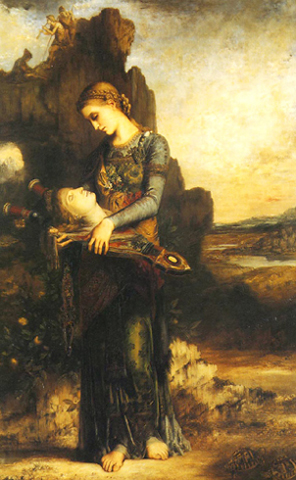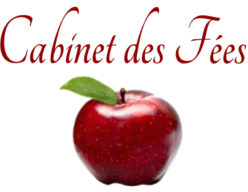Two more days in April: two more poets to celebrate what is the close of National Poetry Month in the United States. Today, we welcome Amal El-Mohtar, no stranger to the digital pages of Cabinet des Fées – she has been published in Scheherezade’s Bequest, she writes book reviews for the site, and has been interviewed in her fearsomely mischievous guise as one-half of the Goblin Queen duo with Jessica P. Wick, editing the succulent poetry quarterly Goblin Fruit. She won the 2009 Rhysling Award with her poem “Song for an Ancient City” and her poetry and prose have ranged the zine-seas, from Mythic Delirium to Sybil’s Garage, from Shimmer to Strange Horizons and beyond. She currently lairs in an Old Library built from dismantled ships, pursuing a PhD in English literature and convincing all the local poor souls that she’s not actually a Queen of Tea and Mischief come among them to steal all their honey.
Today, she gives us a poetic salute to bereft and destroyed Orpheus; this poem was previously published in Sybil’s Garage No. 5.

“Orpheus” by Amal El-Mohtar
The maenads are departed, and the air
lies heavy, empty, still. No wind
rustles shiver-music from the leaves.
Bits of shell remember the tortoise,
float on the river, whisper
lyre, lyre,
tell us a story
lyre, lyre,
sing us a song. All strings
are broken, now, dangle
from the open throat
that cannot swallow.
Muses wept. And yet, a voice,
(that frenzy could not steal or still)
ripples on the waves, distills
an essence from the ether’”
shapes salt and foam and sea
into dark, sweet wine. Orpheus sings, and
I wonder:
is it relief, to know
that he will never turn his head again?
I always find the final lines of this poem strike me to the quick, leave me shuddering much like the first time I read Stephen Mitchell’s translation of Rainer Maria Rilke’s “Orpheus. Eurydice. Hermes.” If it also affects you thusly, then sit still and recover: Amal stopped by for a cup of tea and kindly agreed to an e-mail interview with us.
Deborah: What’s the origin story behind “Orpheus”?
Amal: Once upon a time, in lands far, far away from each other, two young ladies just shy of twenty years of age sat down to create a Poetry Blog, wherein they would post their works-in-progress in a work-a-day fashion, writing poems to the throw of a ten-sided die. One lady, knowing how very much her friend loved stories about Orpheus, decided to try her hand at writing a poem about him for the inaugural Poetry Blog post. It happened very quickly, in a sitting, and as her friend was perfectly delighted by it, the poet decided that it would, of course, be beloved by editors the wide world over.
This was not the case.
It took about four years from penning to publication, when the fine folk at Sybil’s Garage decided to pick it up for their fifth issue. Even then, it garnered a single, one-word review, that word being “unexceptional.” And that, dear lady, is the story of this unfortunate poem about an unfortunate man, beloved only by those who knew it intimately – until now, when your kind self singled it out!
Deborah: I’ve never had the delight of hearing you play, but I understand that you’re a harpist. Has your engagement with the harp influenced your poetry, or vice versa?
Amal: Oh, the influence has definitely gone both ways, but poetry is actually, indirectly, the reason I play the harp. When I was in 9th grade, I told my friend Linh how much I loved Tennyson’s The Lady of Shalott, and she said that I should really listen to Loreena McKennitt, a harpist who’d put that poem to music. Understand that, up until this point, my musical knowledge had been limited to Celine Dion, Ace of Base, Mariah Carey, and classical Arabic music; the idea that people made music of my favourite poetry was fascinating. Linh lent me cassettes of Parallel Dreams and The Visit, and I fell in love with it, feeling that here was my music, music that I could cling to and love, music I wanted to learn to make. My parents being the wonderfully supportive people they are, I was soon learning to play the harp.
Deborah: Just now you’re pursuing graduate work in England, writing your doctoral dissertation on fairies and the Romantics wherein you touch upon Keats. What is your favorite poem by that worthy? Defend your choice!
Amal: So, I wrote an answer to this, and saved it, and my computer ate it. Given that I’d been turning the choice over and over in my head since I wrote it, I take this as a sign.
Originally, I absolutely, unequivocally threw my favour to “La Belle Dame Sans Merci.” I adore that poem completely. I know it by heart. I want to make music for it. I think it’s a perfect poem, and I love it for its ambiguity, its threat, its anguish and ecstasy, for the repetition of “wild,” for the numbered kisses in it. But the poem that has produced the strongest reaction in me – and by “strongest reaction” I mean something that hovers on the outer edges of decency – is his “Ode to a Nightingale,” for a long-winded reason.
When I was little, I read L. M. Montgomery’s Anne of Green Gables, and through it was introduced to a great deal of poets and poetry. I went on to read most of the Anne books, and chased them down with Emily of New Moon, whom I loved even more than Anne. I looked up many of the poets I found in the books, but very few of the actual poems; so much of the time it was “these are lines by Tennyson,” “here is a quote from Keats,” and so on, so I’d find a Complete Works in the library and read what drew my fancy.
Sometimes the lines would get mixed up in my head. For a long time, I associated the lines “charm’d magic casements, opening on the foam / Of perilous seas, in fairylands forlorn” with Tennyson, because in Emily of New Moon there’s an enraptured moment provoked by Tennyson’s “horns of elfland faintly blowing.” Imagine my surprise, then, when throat-deep in “Ode to a Nightingale,” overcome with love for this poem I’d previously never much cared for, never been able to get into, I found those lines. I felt plunged into the perilous seas. I started – please don’t laugh – to cry. I had to stop reading for a moment and just bite my lip and turn the lines over and over in my head, as if they were a key I’d been carrying around for years that had just now been fitted to their proper lock, opening the charm’d magic casement up for me.
So. “Ode to a Nightingale,” then, for profoundly personal reasons, but “La Belle Dame Sans Merci” for perfection.
Deborah: You have a collection of poetry and prose forthcoming from Papaveria Press very soon, each original piece inspired by a variety of honeys you sampled over the course of February 2009. Naturally, the volume is entitled The Honey Month. Could you tell us a little bit about this project?
Amal: With great pleasure. This project was conceived in September 2008, at a diner called “The Diner,” in Somerset, New Jersey, when, suffering from a nasty cold and running on approximately an hour’s sleep, I asked our kind waitress to bring me some honey to mix into my herbal tea. This prompted Danielle Sucher and I to start talking about how much we loved honey, how fascinating and magical a thing it is, how very like wine it is in its capacity for variety of colour, scent, taste. We waxed rhapsodic about the different kinds of honey we’d tried. I said, wouldn’t it be cool to swap honey in the post like some people swap perfume? To send each other samples of these honeys we were describing and review them the way some people review BPAL? Danielle said, yes! Let’s do it!
I failed to anticipate that Danielle, being a fabulous gourmet who ran her own occasional restaurant with her partner, might have a tiny bit more honey than me. By which I mean, I had imagined we would send each other a couple of vials at a time, whenever we came across an interesting new honey. Instead, my first package from Danielle, received some three weeks after we first discussed it, contained thirty-five ½ ml vials, when the sum total of different honeys I’d had in my pantry at any one time was, perhaps, eight.
To try and balance this, I offered to write fiction or poetry in addition to a review of the honeys she’d sent me, while she, being skilled in a number of handcrafts, offered to make different objects for the honeys I sent her. We decided to fix on a month to do this in; I suggested February, partly because it was far enough away that I knew I could be settled into my PhD program in England by then, but mainly because it was the anniversary-month of my giving Catherynne Valente honey and beeswax in Ottawa earlier that year, and because it would be the month in which her novel Palimpsest, with all its connections to bees and honey, would launch. I’d been assisting her with some of the viral marketing for the novel, and had been helping to organize the many Palimpsest shows she was performing with S. J. Tucker all across the country, so since I couldn’t attend any of them from an ocean away, I thought I could maybe offer up this project as a tribute to that as well. Since Cat introduced Danielle and me that weekend in New Jersey, it felt right, and come February I was unstoppering a vial of honey a day, tasting it, reviewing it, and writing something spontaneous for it.
Follow Amal’s blog at Voices on the Midnight Air to find out more about The Honey Month and her mischievous doings. Also, read this post by Erzebet Yellowboy about the two editions of The Honey Month that Papaveria Press will be releasing!
